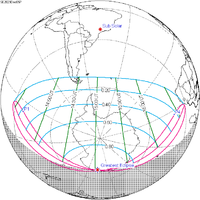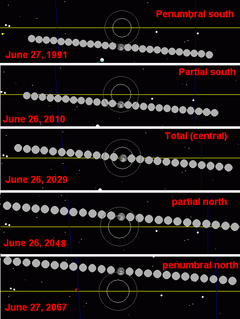December 2029 lunar eclipse
| Total eclipse | |||||||||||||||||
 The Moon's hourly motion shown right to left | |||||||||||||||||
| Date | December 20-21, 2029 | ||||||||||||||||
|---|---|---|---|---|---|---|---|---|---|---|---|---|---|---|---|---|---|
| Gamma | −0.3811 | ||||||||||||||||
| Magnitude | 1.1190 | ||||||||||||||||
| Saros cycle | 135 (24 of 71) | ||||||||||||||||
| Totality | 53 minutes, 44 seconds | ||||||||||||||||
| Partiality | 213 minutes, 18 seconds | ||||||||||||||||
| Penumbral | 358 minutes, 0 seconds | ||||||||||||||||
| |||||||||||||||||
A total lunar eclipse will occur at the Moon’s descending node of orbit on Thursday, December 20, 2029,[1] with an umbral magnitude of 1.1190. A lunar eclipse occurs when the Moon moves into the Earth's shadow, causing the Moon to be darkened. A total lunar eclipse occurs when the Moon's near side entirely passes into the Earth's umbral shadow. Unlike a solar eclipse, which can only be viewed from a relatively small area of the world, a lunar eclipse may be viewed from anywhere on the night side of Earth. A total lunar eclipse can last up to nearly two hours, while a total solar eclipse lasts only a few minutes at any given place, because the Moon's shadow is smaller. Occurring about 4.6 days before apogee (on Sunday, December 16, 2029, at 9:00 UTC), the Moon's apparent diameter will be smaller.[2]
Visibility
The eclipse will be completely visible over northern North America, Africa, Europe, and north, west, and central Asia, seen rising over North and South America and setting over east Asia and Australia.[3]
 
|
Eclipse details
Shown below is a table displaying details about this particular solar eclipse. It describes various parameters pertaining to this eclipse.[4]
| Parameter | Value |
|---|---|
| Penumbral Magnitude | 2.20231 |
| Umbral Magnitude | 1.11895 |
| Gamma | −0.38110 |
| Sun Right Ascension | 17h57m07.6s |
| Sun Declination | -23°26'00.2" |
| Sun Semi-Diameter | 16'15.5" |
| Sun Equatorial Horizontal Parallax | 08.9" |
| Moon Right Ascension | 05h56m59.0s |
| Moon Declination | +23°05'06.7" |
| Moon Semi-Diameter | 15'00.4" |
| Moon Equatorial Horizontal Parallax | 0°55'04.6" |
| ΔT | 73.9 s |
Eclipse season
This eclipse is part of an eclipse season, a period, roughly every six months, when eclipses occur. Only two (or occasionally three) eclipse seasons occur each year, and each season lasts about 35 days and repeats just short of six months (173 days) later; thus two full eclipse seasons always occur each year. Either two or three eclipses happen each eclipse season. In the sequence below, each eclipse is separated by a fortnight.
| December 5 Ascending node (new moon) |
December 20 Descending node (full moon) |
|---|---|
 |

|
| Partial solar eclipse Solar Saros 123 |
Total lunar eclipse Lunar Saros 135 |
Related eclipses
Eclipses in 2029
- A partial solar eclipse on January 14.
- A partial solar eclipse on June 12.
- A total lunar eclipse on June 26.
- A partial solar eclipse on July 11.
- A partial solar eclipse on December 5.
- A total lunar eclipse on December 20.
Metonic
- Preceded by: Lunar eclipse of March 3, 2026
- Followed by: Lunar eclipse of October 8, 2033
Tzolkinex
- Preceded by: Lunar eclipse of November 8, 2022
- Followed by: Lunar eclipse of January 31, 2037
Half-Saros
- Preceded by: Solar eclipse of December 14, 2020
- Followed by: Solar eclipse of December 26, 2038
Tritos
- Preceded by: Lunar eclipse of January 21, 2019
- Followed by: Lunar eclipse of November 18, 2040
Lunar Saros 135
- Preceded by: Lunar eclipse of December 10, 2011
- Followed by: Lunar eclipse of January 1, 2048
Inex
- Preceded by: Lunar eclipse of January 9, 2001
- Followed by: Lunar eclipse of November 30, 2058
Triad
- Preceded by: Lunar eclipse of February 20, 1943
- Followed by: Lunar eclipse of October 21, 2116
Lunar eclipses of 2027–2031
This eclipse is a member of a semester series. An eclipse in a semester series of lunar eclipses repeats approximately every 177 days and 4 hours (a semester) at alternating nodes of the Moon's orbit.[5]
The penumbral lunar eclipses on February 20, 2027 and August 17, 2027 occur in the previous lunar year eclipse set, and the penumbral lunar eclipses on May 7, 2031 and October 30, 2031 occur in the next lunar year eclipse set.
| Lunar eclipse series sets from 2027 to 2031 | ||||||||
|---|---|---|---|---|---|---|---|---|
| Ascending node | Descending node | |||||||
| Saros | Date Viewing |
Type Chart |
Gamma | Saros | Date Viewing |
Type Chart |
Gamma | |
| 110 | 2027 Jul 18
|
Penumbral
|
−1.5759 | 115 | 2028 Jan 12
|
Partial
|
0.9818 | |
| 120 | 2028 Jul 06
|
Partial
|
−0.7904 | 125 | 2028 Dec 31
|
Total
|
0.3258 | |
| 130 | 2029 Jun 26
|
Total
|
0.0124 | 135 | 2029 Dec 20
|
Total
|
−0.3811 | |
| 140 | 2030 Jun 15
|
Partial
|
0.7535 | 145 | 2030 Dec 09
|
Penumbral
|
−1.0732 | |
| 150 | 2031 Jun 05
|
Penumbral
|
1.4732 | |||||
Metonic series
The Metonic cycle repeats nearly exactly every 19 years and represents a Saros cycle plus one lunar year. Because it occurs on the same calendar date, the Earth's shadow will be in nearly the same location relative to the background stars.
| Ascending node | Descending node |
|---|---|
|
|

|

|
Half-Saros cycle
A lunar eclipse will be preceded and followed by solar eclipses by 9 years and 5.5 days (a half saros).[6] This lunar eclipse is related to two total solar eclipses of Solar Saros 142.
| December 14, 2020 | December 26, 2038 |
|---|---|

|

|
See also
Notes
- ^ "December 20–21, 2029 Total Lunar Eclipse (Blood Moon)". timeanddate. Retrieved 20 November 2024.
- ^ "Moon Distances for London, United Kingdom, England". timeanddate. Retrieved 20 November 2024.
- ^ "Total Lunar Eclipse of 2029 Dec 20" (PDF). NASA. Retrieved 20 November 2024.
- ^ "Total Lunar Eclipse of 2029 Dec 20". EclipseWise.com. Retrieved 20 November 2024.
- ^ van Gent, R.H. "Solar- and Lunar-Eclipse Predictions from Antiquity to the Present". A Catalogue of Eclipse Cycles. Utrecht University. Retrieved 6 October 2018.
- ^ Mathematical Astronomy Morsels, Jean Meeus, p.110, Chapter 18, The half-saros
External links
- 2029 Dec 20 chart: Eclipse Predictions by Fred Espenak, NASA/GSFC



